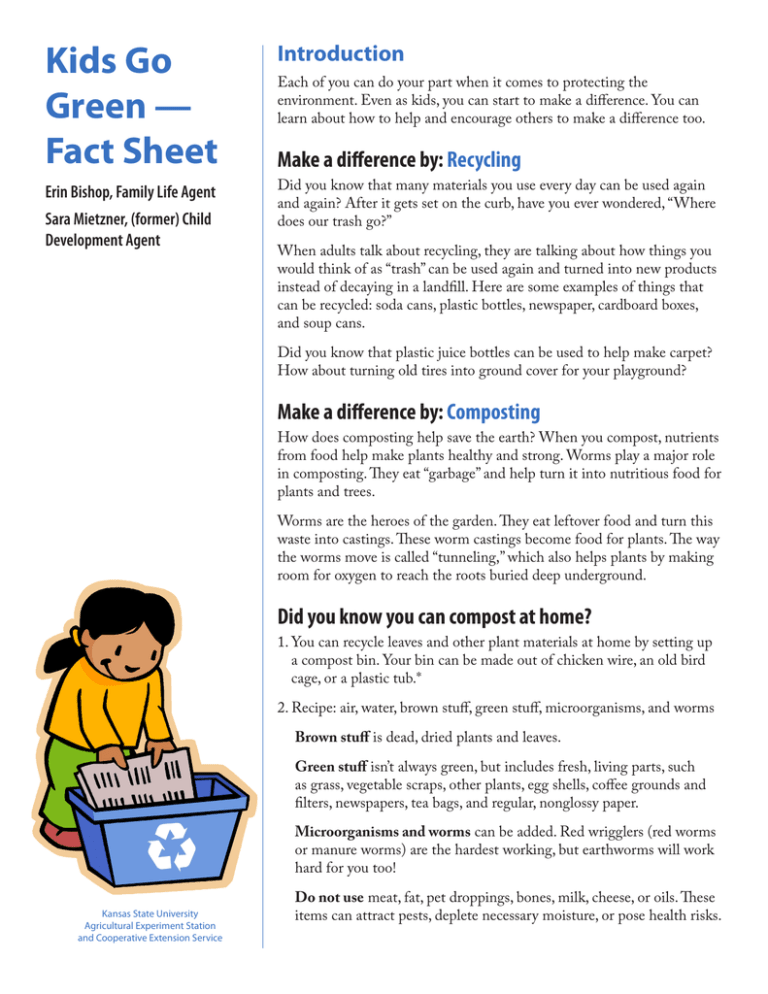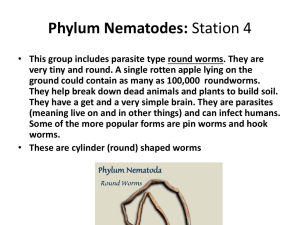
Kids Go
Green —
Fact Sheet
Introduction
Erin Bishop, Family Life Agent
Did you know that many materials you use every day can be used again
and again? After it gets set on the curb, have you ever wondered, “Where
does our trash go?”
Sara Mietzner, (former) Child
Development Agent
Each of you can do your part when it comes to protecting the
environment. Even as kids, you can start to make a difference. You can
learn about how to help and encourage others to make a difference too.
Make a difference by: Recycling
When adults talk about recycling, they are talking about how things you
would think of as “trash” can be used again and turned into new products
instead of decaying in a landfill. Here are some examples of things that
can be recycled: soda cans, plastic bottles, newspaper, cardboard boxes,
and soup cans.
Did you know that plastic juice bottles can be used to help make carpet?
How about turning old tires into ground cover for your playground?
Make a difference by: Composting
How does composting help save the earth? When you compost, nutrients
from food help make plants healthy and strong. Worms play a major role
in composting. They eat “garbage” and help turn it into nutritious food for
plants and trees.
Worms are the heroes of the garden. They eat leftover food and turn this
waste into castings. These worm castings become food for plants. The way
the worms move is called “tunneling,” which also helps plants by making
room for oxygen to reach the roots buried deep underground.
Did you know you can compost at home?
1. You can recycle leaves and other plant materials at home by setting up
a compost bin. Your bin can be made out of chicken wire, an old bird
cage, or a plastic tub.*
2. Recipe: air, water, brown stuff, green stuff, microorganisms, and worms
Brown stuff is dead, dried plants and leaves.
Green stuff isn’t always green, but includes fresh, living parts, such
as grass, vegetable scraps, other plants, egg shells, coffee grounds and
filters, newspapers, tea bags, and regular, nonglossy paper.
Microorganisms and worms can be added. Red wrigglers (red worms
or manure worms) are the hardest working, but earthworms will work
hard for you too!
Kansas State University
Agricultural Experiment Station
and Cooperative Extension Service
Do not use meat, fat, pet droppings, bones, milk, cheese, or oils. These
items can attract pests, deplete necessary moisture, or pose health risks.
3. Once you have added both brown and green stuff, shovel some soil on
top. Repeat this to make layers, as in a cake. Make sure each layer gets a
good sprinkling of water, and add worms as you are making the layers.
(Remember: If you are using a plastic tub, your worms can’t go deep
enough into the ground when the weather turns cold. This could cause
them to freeze and die).
4. Just wait! Microorganisms and worms will now be hard at work.
5. You can keep adding more scraps from your kitchen, grass clippings,
and leaves.
6. Once the materials you have added look like dirt, you have compost.
Compost is dark, earthy-smelling stuff rich in nutrients. Plants love it.
7. Use your compost as mulch around gardens and other plants, or use it
in potting soil.
*To make a plastic tub worm bin, see this website for detailed, kidfriendly directions: http://urbanext.illinois.edu/worms/
Make a difference by: Conserving
What does conserving mean, and how can little changes help save the
earth? Conserving is another word for saving. When you conserve energy,
you are helping save resources often lost through wasteful behaviors.
Some examples of conserving behaviors might include:
• turning off the water while brushing your teeth,
• turning off lights on when you leave the room,
• turning off the car when you stop at the grocery store, or
• turning off your video game when you leave to go to your friend’s
house.
What other ways can you think of to conserve energy?
If everyone learns to conserve more energy, the planet will be a cleaner,
healthier place with more resources for everyone to enjoy.
Make a difference by: Reusing
Can your used items be turned into other things? How can you give
things a “new life” before sending them to the dump? When you reuse
items, you give them a second chance at becoming something unique and
creative. Some things you can reuse or “make new” include the following:
• Shoeboxes — can become keepsake boxes.
• Empty tin cans — can become pencil holders.
• Empty, clean baby food jars — can store buttons.
• Old T-shirts — can be made into grocery bags.
2
What other things can you reuse?
By reusing, you can create less waste and help give your “trash” a new life.
Fun websites to check out
• Adventures of Herman the Worm: urbanext.illinois.edu/worms/
• County of San Mateo Recycle Works: www.recycleworks.org/kids/
• Environmental Kids Club: www.epa.gov/kids/
• Nick Jr. Creative Recycling: www.nickjr.com/crafts/all-shows/creativerecycling-crafts/all-ages/index.jhtml
• Junior Master Gardeners: jmgkids.us
Activity
Use the word bank to help you find all the words in this word search
puzzle. Words go across forward and backward, up and down, and
diagonally.
Kids Go Green Word Search
T
K
G
R
E
E
N
L
E
E
O
T
N
E
M
N
O
R
I
V
N
E
R
E
C
Y
C
L
E
W
R
P
S
F
E
P
S
D
O
A
P
E
L
U
D
N
D
P
M
S
D
Z
S
A
E
X
B
G
U
T
R
K
U
N
N
R
M
H
X
E
C
U
O
X
O
T
R
H
T
R
A
E
E
P
W
C
S
D
CONSERVE
GREEN
REDUCE
WORMS
PLANTS
REUSE
3
ENVIRONMENT
RECYCLE
WASTE
References:
Brendler, C. (2009). Winnie Finn, Worm Farmer. Farrar Straus Giroux:
New York.
Krug, D. (2009). It’s Easy to be Green, Fact Sheet (MF2886). K-State
Research and Extension.
Pfeffer, W. (2004). Wiggling Worms at Work. Harper Collins: New York.
Marr, C. (1992). Making and Using Compost at Home (MF1053). KSU
Horticulture Report. K-State Research and Extension.
Missouri Department of Natural Resources: Division of Environmental
Quality (2008). Quart Jar Worm Farm. http://dnr.mo.gov/env/swmp/
worms/wormjar.htm
Urban Programming Resource Network: University of Illinois Extension.
(no date) Adventures of Herman the Worm. http://urbanext.illinois.ed tt
Authors
Erin Bishop, Family Life Agent, K-State Research and Extension –
Fort Riley
Sara Mietzner, former Child Development Agent, K-State Research and
Extension – Fort Riley
Reviewers
Karen Blakeslee, Extension Associate, Food Safety, K-State Research
and Extension
Donna Krug, Family and Consumer Sciences Agent, K-State Research
and Extension – Barton County
Brand names appearing in this publication are for product identification purposes only.
No endorsement is intended, nor is criticism implied of similar products not mentioned.
Publications from Kansas State University are available at: www.ksre.ksu.edu
Publications are reviewed or revised annually by appropriate faculty to reflect current research and practice.
Date shown is that of publication or last revision.
Contents of this publication may be freely reproduced for educational purposes.
All other rights reserved.
In each case, credit Erin Bishop, et al, Kids Go Green, Fact Sheet,
Kansas State University, July 2011.
Kansas State University Agricultural Experiment Station and Cooperative Extension Service
MF2983
July 2011
K-State Research and Extension is an equal opportunity provider and employer. Issued in furtherance of Cooperative Extension Work, Acts of May 8 and June 30, 1914,
as amended. Kansas State University, County Extension Councils, Extension Districts, and United States Department of Agriculture Cooperating, Gary Pierzynski, Interim
Director.





